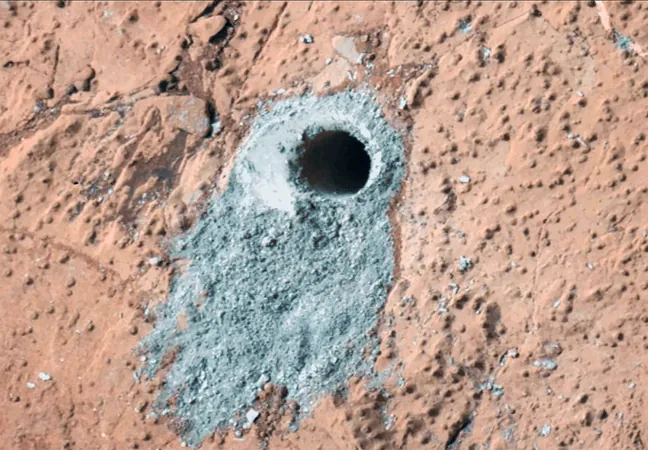
Mars Rover Makes Groundbreaking Discovery: Are We Closer to Finding Alien Life?
2025-03-31
Author: Olivia
NASA’s Curiosity rover has achieved an exciting milestone in its mission to uncover the secrets of Mars—unearthing the largest organic compounds ever identified on the planet! These remarkable molecules, which were found in a rock sample drilled back in 2013, offer fresh insights into the possibility that Mars once had the ability to support life.
The findings suggest that Mars might have been home to more complex prebiotic chemicals than previously imagined. Inside Curiosity's onboard laboratory, the Sample Analysis at Mars (SAM) tool, scientists detected three significant organic molecules: decane, undecane, and dodecane—which contain 10, 11, and 12 carbon atoms, respectively. Researchers believe these compounds are remnants of fatty acids, critical components often associated with life on Earth.
Why Are Fatty Acids Important?
On Earth, fatty acids are fundamental to the structure of living cells. They play a crucial role in forming cell membranes, linking up with other molecules to create phospholipids, which provide protection and structure to every cell in our bodies. Beyond their structural functions, fatty acids are vital for energy storage and communication within and between cells, ensuring that life continues to thrive.
The discovery of these molecules on Mars is exhilarating—it indicates that the planet once had the right conditions for intricate chemical processes and possibly life itself.
A Rock Sample That Keeps Giving
Curiosity drilled into the rock target known as "Cumberland" back on May 19, 2013. Scientists believed this area mirrored an ancient lakebed, and they were correct. Rich in clay, sulfur, and nitrates, the rock preserved organic materials extraordinarily well. The presence of methane, often linked to biological processes on Earth, further fuels optimism about life on Mars.
According to Daniel Glavin, a senior scientist at NASA’s Goddard Space Flight Center, “There is evidence that liquid water existed in Gale Crater for millions of years and probably much longer, which means there was enough time for life-forming chemistry to happen in these crater-lake environments.”
An Unexpected Twist in Discovery
Interestingly, these organic compounds were discovered unintentionally while scientists were initially searching for amino acids in the rock sample. Upon heating the sample, they identified small amounts of decane, undecane, and dodecane, leading to hypotheses about their origins. Laboratory simulations on Earth confirmed that similar heating processes could yield these organic compounds from longer-chain fatty acids.
What’s astonishing is that the detected fatty acids were longer than those typically created through geological activities. This suggests potential signs of ancient biological processes, highlighting that Mars might have once hosted conditions conducive to life.
Implications for Future Missions
This research strongly supports the notion that organic molecules can endure Mars's harsh conditions, despite the destructive forces of radiation and oxidation. The preservation of organic materials in the Cumberland sample spurs hope for future explorations and discoveries.
Curiosity, however, has limitations in its analytical capabilities, which is why scientists are eager to return samples from Mars to Earth for more comprehensive studies. Glavin emphasizes, “We are ready to take the next big step and bring Mars samples home to our labs to settle the debate about life on Mars.”
As Curiosity continues to navigate Gale Crater, examining rock layers to better understand Mars's ancient environments, each new sample brings humanity closer to answering one of our most profound questions: Did life ever arise on Mars, and if so, what other clues lie beneath the surface?
Stay tuned for further updates on this thrilling journey into Mars’ past—could we finally be on the brink of discovering extraterrestrial life?









 Brasil (PT)
Brasil (PT)
 Canada (EN)
Canada (EN)
 Chile (ES)
Chile (ES)
 Česko (CS)
Česko (CS)
 대한민국 (KO)
대한민국 (KO)
 España (ES)
España (ES)
 France (FR)
France (FR)
 Hong Kong (EN)
Hong Kong (EN)
 Italia (IT)
Italia (IT)
 日本 (JA)
日本 (JA)
 Magyarország (HU)
Magyarország (HU)
 Norge (NO)
Norge (NO)
 Polska (PL)
Polska (PL)
 Schweiz (DE)
Schweiz (DE)
 Singapore (EN)
Singapore (EN)
 Sverige (SV)
Sverige (SV)
 Suomi (FI)
Suomi (FI)
 Türkiye (TR)
Türkiye (TR)
 الإمارات العربية المتحدة (AR)
الإمارات العربية المتحدة (AR)